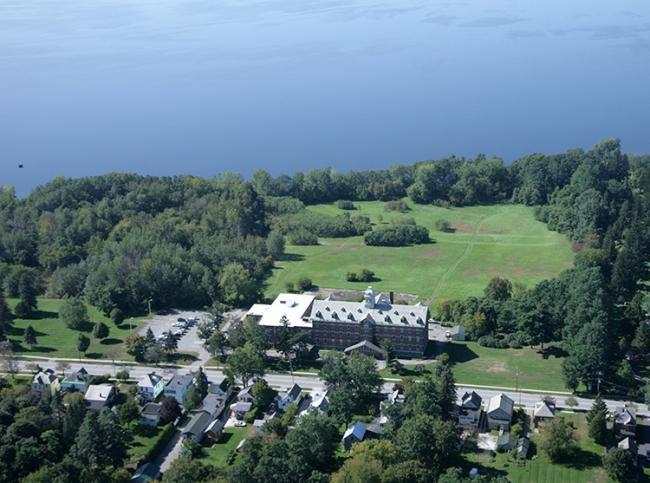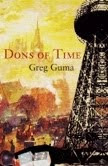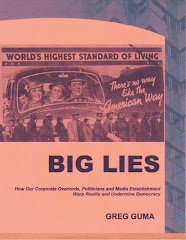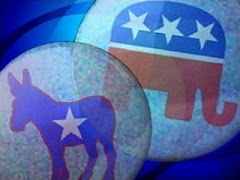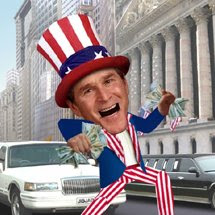At the height of the Clinton impeachment
"crisis," both defenders and critics of the embattled president often
referred to what they liked to called "those stubborn facts,"
basically bits of information the other side preferred not to acknowledge. Mass
media seized any opportunity to exploit such disputes, offering
themselves as even-handed defenders of fairness and truth.
But just a few
months later, facts became irrelevant as the US and NATO geared up for a war in
Yugoslavia, and the same media outlets redefined their role as unofficial
government spokespersons.
In order to convince an initially
skeptical public that air strikes, and possibly even a ground war, were
justified, several arguments were offered. For instance, officials claimed that
the government of Slobodan Milosevic had refused to negotiate on Kosovo, and
was engaged in a brutal campaign of "ethnic cleansing" that bordered
on genocide. NATO, on the other hand, was intervening to prevent a "humanitarian
catastrophe," and sought only to alleviate human suffering and defend the
rights of Kosovo's Muslim Albanians. Unfortunately, another series of
"stubborn facts," all but censored once the bombing began,
contradicted those comforting assertions.
First, there were the pre-war
negotiations. In February, 1999, when peace talks began in France,
Yugoslavia was given an ultimatum: Grant Kosovo autonomy and let NATO station
30,000 troops there for the next three years -- or face the consequences. Contrary to reports,
only the stationing of troops was rejected, on the grounds that it violated
Yugoslavia's sovereignty. If anyone was refusing to negotiate, it appeared to
be the US and NATO.
But the relentless use of buzzwords like
ethnic cleansing and genocide, plus the redefinition of Milosevic as the
world's new “Hitler," quickly gave this unyielding stance the veneer of
humanitarian concern. Usually omitted was the inconvenient reality that the
violence in Kosovo was a part of an ongoing struggle between the government and
separatists, who had been actively waging civil war for at least two years.
Beginning in October, 1998, the well-armed Kosovo Liberation Army (KLA), an
extremist group with connections to Osama Bin Laden and drug smuggling, staged
more than 200 attacks on government facilities and local leaders hostile to
independence. The following February, the New York Times announced that KLA
fighters would be brought to the US for training. You didn't have to be an
apologist for Milosevic to recognize that such developments contributed greatly
to his government's overreaction.
Another stubborn fact was the US role in
setting the stage for conflict, while turning a blind eye to inconvenient
catastrophes. The breakdown of Yugoslavia, which began with the death of
President Tito in 1980, was largely ignored outside Europe until it ignited
regional war in the 1990s. With the collapse of the Soviet Union no serious
effort was made by Europe, the UN or the US, to safeguard the growth of
democracy or political tolerance. Instead, US policy was preoccupied with
finding a quick fix that would protect strategic and economic interests in
Europe. After advocating Yugoslavian unity for too long, subsequent US mistakes
included isolating the Serbs, prematurely recognizing Croatia, and imposing
one-sided sanctions. According to Pentagon thinking, the desirable US strategy
was to use the threat of military intervention to restore the status quo. In
1992, sanctions and diplomatic isolation destroyed efforts to build a new political
structure in what was left of the country.
The biggest single act of "ethnic
cleansing" in the region was the 1995 forced removal of 600,000 Serbs from
the Krajina region of Croatia (a former Yugoslav republic) by the US-trained
and armed Croatian military. Some of the 55,000 Serbs resettled afterward in
Kosovo were among the refugees we subsequently saw on TV during the 1999 war.
In the past, US policy had sanctioned the removal of Kurdish people in Turkey,
as well as Palestinians, East Timorese, Guatemalan indigenous people, and many
more.
So, why intervene, and why against the
Serbs? Contrary to official spin, the apparent US/NATO agenda was to break
Yugoslavia into smaller pieces. The Balkans is a strategic region, a crossroads
between Western Europe and the oil-rich Middle East and Caspian Basin. In
addition to land routes, the Danube may someday carry gas from the ex-Soviet
Caucasus to West Europe via the Rhine. In the 1990s, the Western powers had
gained effective control over the former Yugoslav republics of Croatia, Bosnia,
and Macedonia, as well as Hungary and Albania. The only hold out was the
Federal Republic of Yugoslavia. In short, it stood in the path of the New World
Order.
With the collapse of the Soviet Union,
NATO needed fresh and powerful reasons to stay in business. Thanks to Kosovo,
it was able to celebrate its 50th anniversary by consecrating a new global
mission: intervention anywhere in the world on humanitarian grounds. The recipe
was deceptively simple: Arm a group of radical secessionists to ambush
policemen and define the inevitable government retaliation as "ethnic
cleansing." Next, promise the rebels that NATO will bomb their enemy if
the fighting persists, and call the resulting mayhem a challenge to NATO's
"resolve" that must be answered by military force. In the case of
Yugoslavia, the KLA had nothing to lose it; refugees and casualties would help
to prove a "humanitarian catastrophe" was underway, ultimately
bringing NATO and the US into the conflict on its side. For the Serbs,
restraint seemed pointless. Clearly, they would be blamed for whatever
happened.
Waiting
for the Body Count
On February 23, 1999, James Hooper,
director of the Balkan Action Council, gave a revealing speech at the Holocaust
Museum in Washington, DC, at the invitation of its "Committee of
Conscience." The Council was one of several think tanks that sprang up to
justify the transformation of the former Yugoslavia into a NATO protectorate.
The first item on Hooper's to-do list was to "accept that the Balkans are
a region of strategic interest for the United States, the new Berlin if you
will, the testing ground for NATO's resolve and US leadership."
Writing about NATO in the French daily
Le Monde early in the war, Jean-Christophe Rufin, former vice president of
Doctors Without Borders, described it as "a purely military, operational
alliance, designed to respond to a threat, that is, to an enemy. NATO defines
an enemy, threatens it, then eventually strikes and destroys it. Setting such a
machine in motion requires a detonator. Today it is no longer military. Nor is
it political. The evidence is before us: NATO's trigger today is...
humanitarian. It takes blood, a massacre, something that will outrage public
opinion so that it will welcome a violent reaction."
Civilians were targets in Kosovo largely
because victims were the key to international outrage and reaction. "Let's
be clear: the West wants dead bodies," Rufin advised. "We are waiting
for them in Kosovo. We'll get them." In the middle of such a conflict,
massacres can easily occur. And if not, they can be "arranged." There
is almost always a camera at hand.
In 1993, for example, Croatian officers staged a "Serbian bombing" of the Croatian coastal city of
Sibenik for Croatian TV crews. When the scheme was exposed six years later, the
former Commander of the 113th Croatian brigade headquarters became indignant.
"Why so much fuss?" Davo Skugor complained. "There is no city in
Croatia in which such tactical tricks were not used. After all, they are an
integral part of strategic planning. That's only one in a series of stratagems
we've resorted to during the war."
Ignoring those and other "stubborn
facts" during the attack on Yugoslavia, most of the media's talking heads
instead assumed the role of cheerleader for the Western military and KLA, often
repeating stories that turned out to be false. The fabrications began even
before the bombing with the report of a "massacre" at Racak, the
event that triggered the doomed "peace talks." In this case, the
source was US State Department veteran William Walker, a former US ambassador
to El Salvador and Nicaragua and player in the covert 1980s campaign to supply
the Contras.
Walker was US ambassador to Yugoslavia at the time. His version of
Racak was soon challenged by documentary film footage. But the disinformation
continued, complete with inflated casualty and refugee figures, silence about
KLA attacks and atrocities, and the claim (later proven false) that Albanian
leader Ibrahim Rugova had been assassinated. That actually may have been a case
of wishful thinking, much like the premature announcement that Venezuelan
President Hugo Chavez, a thorn for US oil companies, had been overthrown in
April 2002; Chavez was back in his office within two days of an attempted coup.
In Rugova’s case, the US/NATO concern was that he had condemned the attack and
seemed more willing to negotiate with Milosevic than those claiming to defend
Albanian interests.
What really happened in Rajak? According
to a team of Finnish pathologists sent in to investigate, Serbian police
entered the village, a KLA stronghold, on January 15, 1999. Observers from an
Organization for Security and Cooperation in Europe (OSCE) Verification Mission
and an Associated Press video team tagged along. In the ensuing fire fight,
Serb police bested their attackers. The next day, however, KLA combatants led
international media and Walker, who also headed the OSCE mission, to a gully at
the edge of town littered with corpses.
After the KLA showed the group the
bodies of about 40 people, Walker immediately cried "massacre,"
accusing Serbia's security forces of killing "unarmed civilians." The
story went global. Describing the incident as "a deliberate and arbitrary act
of murder," President Clinton issued a harsh condemnation. The German
foreign ministry agreed, warning those responsible that "the international
community is not prepared to accept the brutal persecution and murder of
civilians in Kosovo."
The Yugoslav government denied the
accusation, accusing the KLA of gathering the corpses of its own fighters and
arranging them to resemble a mass execution. But hardly anyone was buying. What
soon became known as the "Racak massacre" had made NATO intervention
a virtual certainty. The Washington Post later reported that Rajak
"transformed the West's Balkan policy as singular events seldom do."
Soon after January 15, NATO held an emergency meeting, during which US
Secretary of State Madeleine Albright recommended bombing Yugoslavia as
"punishment." But before the punishment could be administered,
Washington had to go through the charade of "peace talks" in
Rambouillet. The strategy here was apparently to issue demands that the
Yugoslav regime could not accept.
In February, forensic experts arrived
from Belarus and Finland. The Belarus team said there was no massacre, but the
Finnish spokesperson issued a vague report that allowed Walker's charges to
stand. A year later, the same team was no longer so sure. According to a May
2000 CBC Radio News report, a Finnish pathologist's autopsies revealed no
evidence that the 40 bodies were intentionally mutilated. Only one of them
showed signs of murder at close range. The most plausible explanation turned
out to be that KLA fighters were killed in a fire fight. But the truth had been
suppressed long enough to help shape public opinion.
By identifying Albanians as
"victims" and Serbs as villains from the outset, the US and its
allies were able to effectively short-circuit any meaningful debate. The
Clinton administration also insisted that the Kosovar Albanians only wanted
US-style democracy (their actual goal was control over territory), and that
democracy, combined with a free market economy, would ultimately solve their
problems. But NATO/US intervention was meanwhile making a bad situation worse,
in effect creating the humanitarian catastrophe it was supposed to avert.
Behind the scenes, a Brzezinski-style
geostrategy was being played out: successful prosecution of the war would help
to secure potential pipeline routes to Caspian oil, while expanding NATO's role
as an tool of Western hegemony over Eurasia. The result was a convenient
fiction that made reality virtually impossible to detect.
Specious
Logic
As the war escalated, both backers and
opponents became adamant, and marshaled more "facts" to support their
positions. Critics of bombing noted that NATO and the US had not negotiated in
good faith, or taken steps to deal with the refugee flow that predictably
followed, even though they probably expected it. Supporters pointed to the mass
removal of Albanians before the bombing, Milosevic's past betrayals and crimes,
and evidence of atrocities. To some extent, both sides were right.
During a conversation with an old friend
-- once an anti-war activist, now a government staffer -- I suggested that
the decision to bomb had more to do with NATO's credibility and US influence in
Europe than protecting Kosovo Albanians or defense of human rights. He
responded, "Milosevic is a brutal dictator and something had to be done to
stop genocide. I'm not a pacifist." But equating opposition to bombing
with pacifism, along with the argument that military action was justified by
the mere charge of genocide, betrayed the myopic thinking of many supporting
"diplomacy backed by force."
The real issue was not choosing between
doing nothing and "something" -- that is, going to war. It was
whether bombing, or even a ground war, would solve the problem. As it turned
out, NATO's battle plan murderously misfired. The results included an
accelerated flow of refugees, increased ethnic hatred, and destruction of
Yugoslavia's infrastructure and democratic opposition. Despite eventual
"success," international law was weakened, higher US defense spending
was justified, and the notion that the US and NATO should act as
"humanitarian" globocops was considerably advanced.
For many people, the genocide argument
was especially persuasive. But ethnic cleansing is not genocide, and equating
them trivializes the latter. Only a few months before the bombing began,
Germany's Foreign Office had argued that neither ethnic cleansing nor genocide
were occurring. A January, 1999 intelligence report stated that, "Even in
Kosovo an explicit political persecution linked to Albanian ethnicity is not
verifiable. The East of Kosovo is still not involved in armed conflict. Public
life in cities like Pristina, Urosevac, Gnjilan, etc. has, in the entire
conflict period, continued on a relatively normal basis." The "actions
of the security forces (were) not directed against the Kosovo-Albanians as an
ethnically defined group, but against the military opponent and its actual or
alleged supporters."
Lacking that rationale, some insisted
the mission was "just" in any case. The fact that the US had failed
to act in the past, many times even supporting murderous regimes, did not mean
it couldn't do the right thing this time. So went the thinking at least. But
the campaign did little to help the victims, while hurting many civilians and
visiting untold damage on the environment throughout Serbia and Kosovo.
Three
years after extensive bombing, the UN found widespread low-level contamination
due to the use of depleted uranium. Although UN scientists insisted that the
levels did not pose a direct threat to human health, they did express concern
about a potential risk of contaminated water sources due to the ammunition tips
made out of depleted uranium. In other words, people were safe unless they
drank the water. Expressing surprise that depleted uranium dust was still in
the air, the researchers urged authorities to fence off and monitor affected
sites.
So, if Milosevic was a mugger and the
Kosovars his victim, NATO might be called the macho bystander who decided to
"help" by wildly firing a shotgun.
There is no doubt that crimes against
humanity were committed. But more than one defendant might have been charges.
According to UN Human Rights Commission Chair Mary Robinson, an international
war crimes tribunal could have investigated all sides. "The actions of
individuals belonging to Serb forces, the Kosovo Liberation Army (KLA), or NATO
may therefore come under scrutiny, if it appears that serious violations of
international humanitarian law have occurred," she announced in May, 1999.
As it happened, however, only Milosevic and some Serb accomplices were indicted
and tried.
Those who said that bombing "was
better than doing nothing" also ignored the fact that other options were
available. Why weren't they pursued? Mainly because the main objective was not
to protect Kosovo Albanians, but rather to prevent ethnic conflict from
affecting other parts of Europe (a central reason why independence for Kosovo
wasn't on the negotiating table), while advancing the role of NATO as enforcer of
what it called "collective security."
The Soviet Union's break up had made
NATO's original mandate obsolete. The new agenda, as advocated by the US,
involved a more assertive stance, including operations to stop ethnic violence
and counter weapons of mass destruction inside and beyond the Alliance's
borders. According to NATO's founding documents, however, it was obligated not
to use force in any manner inconsistent with the UN Charter, essentially
leaving that decision to the Security Council. The US nevertheless argued that
the alliance should have the right to act if UN approval could not be obtained.
Or, apparently, if it didn't bother to ask. The Yugoslavia war made this
official policy.
In response to the charge that NATO's
intervention violated Yugoslavia's sovereignty, some experts suggested that
sovereignty is a dubious right that should have limits. In the abstract, it is
difficult to disagree. But that thinking essentially puts the strong, usually
the US or another northern industrial state, in the position of punishing the
weak whenever they see fit. No doubt the same argument wouldn't fly if Turkey,
a NATO member, was bombed for its treatment of the Kurds.
And the final fallback? Despite
questionable NATO and US motives, supporters argued that the military's success
in stopping Milosevic made it all worthwhile. But given the actual consequences
-- more deaths, a damaged environment, the undermining of international law,
and so on - this could be the most cynical argument of all.


